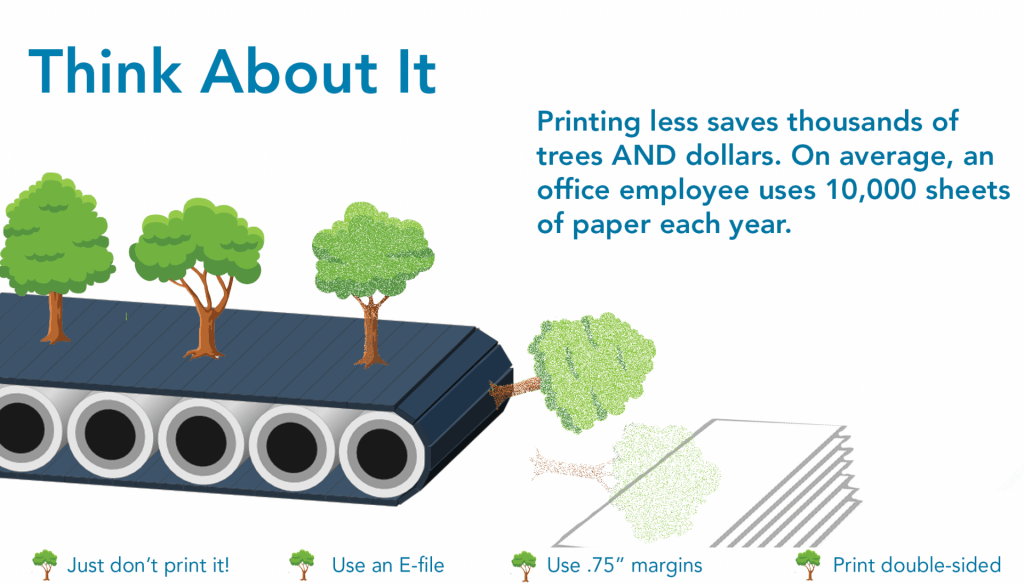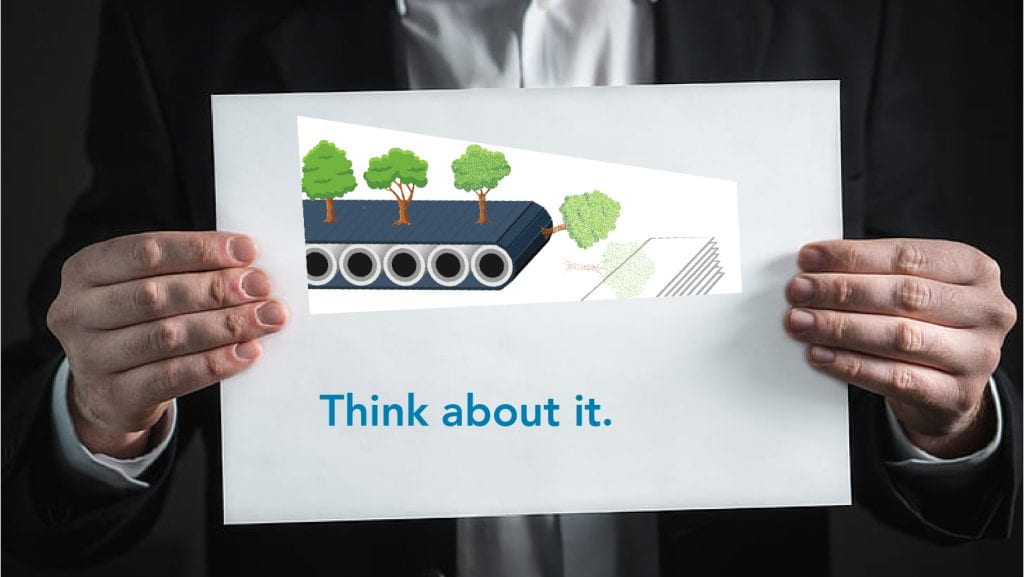Imagine that you are a student at Olin Library, your arms outstretched with an ID, ready to print out a reading for your class this afternoon. The papers come out nice and warm, from a printer that is hot to the touch. You staple the pages together, retreat to a booth in Whisper’s, and highlight the parts that are important for your discussion. The next day, those papers are tossed in the recycle bin, never to be read or touched again.
Or, imagine that you’re a professor. You teach a class in a large lecture hall and print out a heavy stack of syllabuses for your students to pass around on the first day of class. After all, professors aren’t charged for printing – papers magically appear out of the department printer. When your students leave your classroom at the end of the lecture, one hands back the pile of paper, and you notice that there is barely a dent in the stack. On the ground, more single-sided syllabuses with wide margins drift by. The remaining stack goes into the recycle bin.
Every day, we use paper without thinking. Office staff print out email responses to file away, and toss out entire boxes of brochures or envelopes when they discover a typo. Professors pass out hard copies of dense readings to students, and request physical copies of student essays to slide under their office doors. Students forget to print double-sided, or print out too many fliers for their clubs. You think to yourself, as long it’s recycled, it’s fine, right? But what about the embodied energy and resources that went into making those papers, or the costs of renting the printers and buying the toners, all to be tossed away after a brief use? What are the consequences for printing paper without thinking?
Myth #1: “It’s okay to use paper, as long as I put it in the recycle bin.”
Recycling paper requires a lot of energy – from transporting the papers to a recycling center, producing new paper, to distributing the paper, and more. Even after all that, paper production still includes natural resources. Most papers on campus either comes from 100% virgin (new) paper fibers or has a mere 30% recycled content, which means that they still require trees to produce and are mostly made from new natural resources.
Furthermore, the current market demand for papers that have been sorted through the recycling system is low due to major changes in the willingness of countries like China and India to buy them and turn them into new paper. This is because when paper goes through the single-stream recycling process, there can be high levels of contamination, which lowers the value of this commodity. When recycled commodities like paper and plastic have little value, recycling becomes expensive and cannot compete with landfill costs.
Myth #2: “Because paper comes from trees, a renewable resource, it is okay to continue to use paper without considering the impacts.”
Trees on tree farms are planted specifically for producing paper. Most paper forests are planted on deforested land that used to contain centuries-old forests. Old-growth forests, with their dynamic ecosystems and skyscraper trees, are major carbon sinks that help regulate Earth’s temperature through absorbing and storing huge amounts of carbon dioxide from the atmosphere. They are also the greatest repositories of biodiversity on the planet. Paper forests, full of well-managed monocultures of young trees planted in neat rows, can never achieve that kind of carbon sequestration. The deforestation of old-growth forests is a major contributor to climate change, whether it’s done for paper forests, to graze cattle for beef, to plant palm oil trees or soybean fields.
Fact #1: In order to decrease market demand for virgin paper fibers, it is important that we – staff, faculty and students – use less paper.
The “greenest” sheet of paper will always be the one you don’t print. Check the strategies below so you can have the same desired outcomes using digital solutions. Printing less will also save you money. Paper with recycled content is more expensive, but when paired with savings from printing less, the switch will be cost-neutral.
Fact #2: Purchasing papers with recycled content significantly decreases natural resource consumption, water use, and greenhouse gas emissions.
When we do print, we should consider buying and printing on papers made with recycled fibers that are sourced from previously used papers. Buying papers with recycled content increases the market demand for recycled paper fibers, thus supporting the recycling industry and closing the loop. When recycled content replaces virgin fibers, we save trees and decrease the pressure on both tree farms and old-growth forests.
By using the Paper Calculator developed by the Environmental Paper Network, anyone can see how shifting their own paper purchasing will impact water, natural resources, and green house gas emissions. An analysis of WashU’s paper usage suggests that if all departments shifted to 30% recycled content, we would use 61 less tons of wood, burn 150 million less BTUs, and avoid 159,000 lbs of CO2 from being emitted into the atmosphere, every year.
Between FY18 and FY19, WashU departments spent about a half million dollars on copy paper. In this time period, recycled content paper purchases have increased by 6%, and overall paper usage has reduced by 12%. Efforts from students and staff to reduce paper usage, paired with the general trend to digitize documents, has made an impact. Still, 71% of paper purchase have no recycled content.
Office Essentials, the preferred vendor of office supplies for WashU, has implemented some measures to encourage WashU offices and departments to purchase papers with recycled content instead of 100% virgin fibers, making it easier to find and more affordable. In addition, if you select “regular” paper in MarketPlace, you may see a pop-up message encouraging you to consider the 30% recycled content paper instead. After all, all the cool kids are doing it…
How you can help
- Avoid printing where possible, and think deeply about the decision when you do. If you do print, limit the number of pages as much as possible.
- Play around with settings on PaperCut or within the settings of the document you are printing: Decrease the margins and print on both sides of paper. For papers that have larger text, you can even print two pages on one side of the paper!
- Pay close attention to your “Print Summary” on Papercut. Set a personal goal to reduce your paper use semester to semester! Be aware of how much you’re printing and the impact it has on our earth.
- Collect scrap paper and consider using it when printing non-official documents.
- Get the “Think About It” flier and place it by your printer to remind users to be mindful of their printing practices.
- If your department doesn’t already track paper use, check with the copy machine vendor to see if they can help set this up. You can’t improve what you don’t measure!
- Learn how to identify papers that are made of recyclable content, such as brands with recyclable symbols and percentages or FSC, SFI, or PEFC certification. Check out this resource to learn more.
- Always ask for recycled content paper, whether it’s within your department, in a computer lab you use a lot, or through when printing off-campus through a vendor.
You can learn more about how to format your document for paper savings, sourcing recycled content paper through WashU’s MarketPlace, and decoding paper certifications here.

Flier to place by your printer to remind users to be mindful about their printing practices.
This article was written by Jarea Fang, Communication Associate at the Office of Sustainability.
